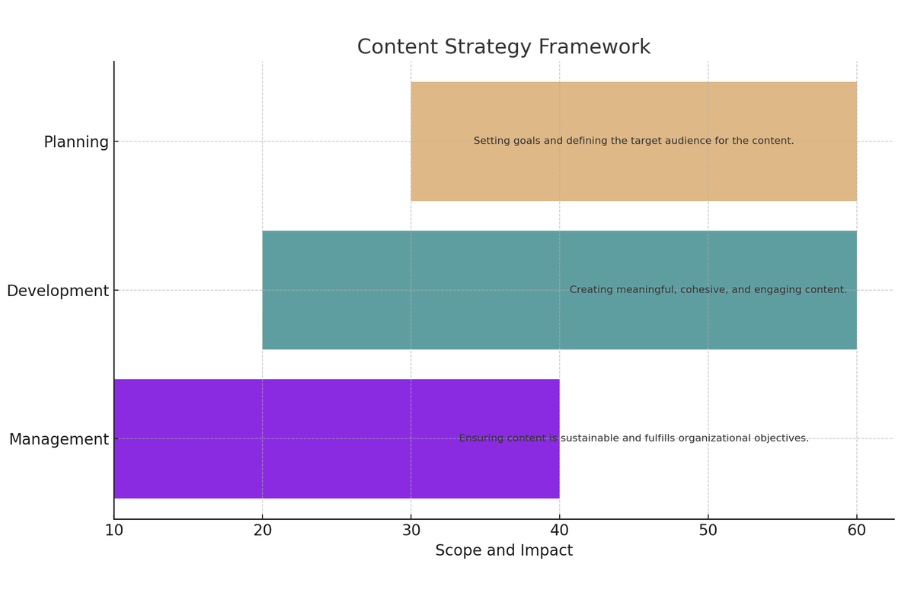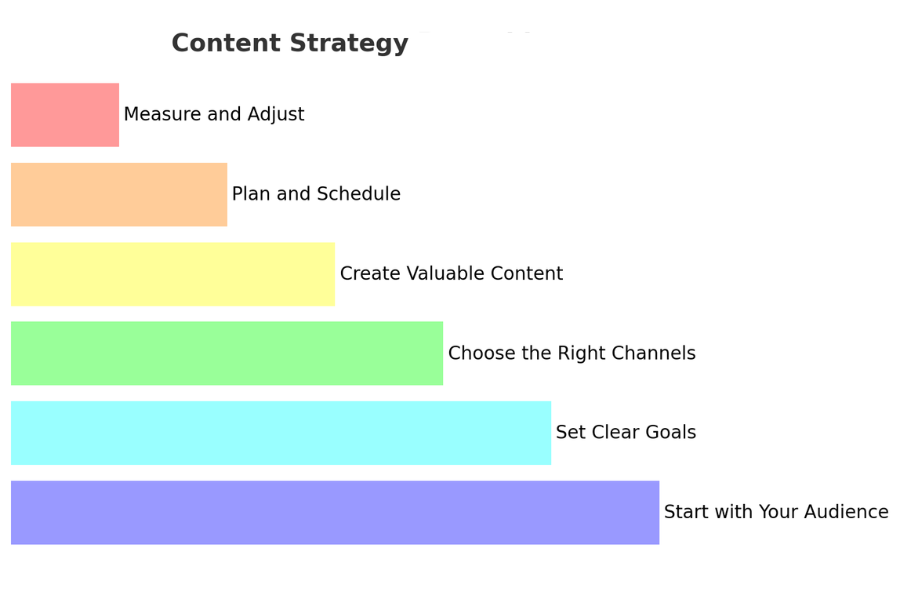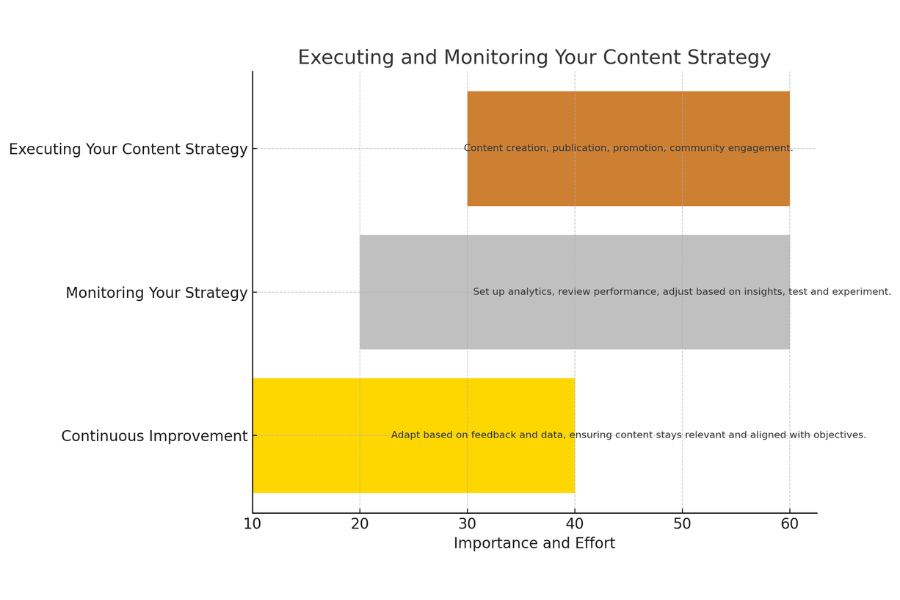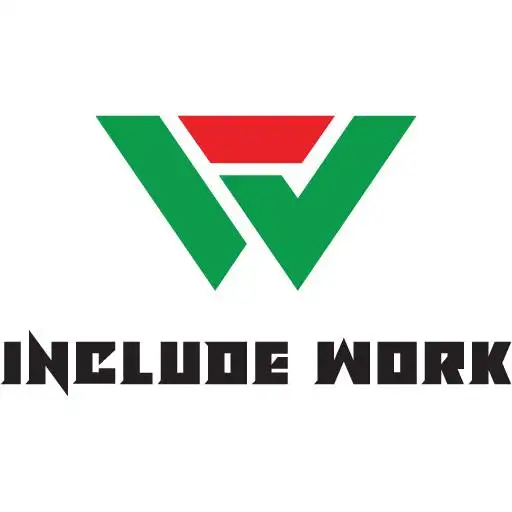Content strategy stands at the intersection of art and science. It’s about managing every facet of a brand’s or organization’s content. The goal is to ensure that this content aligns with the brand’s overarching goals. It also aims to meet the audience’s needs. This strategy covers the planning, development, distribution, and management of content. It spans various platforms and media types.
Table of Contents
A well-crafted content strategy empowers businesses. It enables them to engage their audience effectively. They can convey their message clearly and meet their marketing and communication goals. The process involves a deep understanding of the target audience. It requires creating a content calendar and choosing the best channels for distribution. Also, it involves measuring the impact of content initiatives.
By creating compelling narratives and valuable information, the aim is to build trust. It also fosters loyalty and drives meaningful actions among consumers. Content strategy is more than just content creation. It’s about crafting the right content. Content that resonates, informs, and inspires.
What is content strategy?
Content strategy refers to the planning, development, and management of content—written or in other media. The goal of content strategy is to create meaningful, cohesive, engaging, and sustainable content that attracts the target audience and fulfills the objectives of the organization.

Creating a Compelling Content Strategy
Creating a compelling content strategy is like drawing a map for your brand’s journey online. It serves as a plan for producing, sharing, and managing content to reach your business objectives. In today’s changing digital world, a strong content strategy is essential, not just a luxury. Here’s how to craft one that speaks to your audience and makes you stand out from the competition.
Start with Your Audience
The foundation of a great content strategy is understanding your audience. Who are they? What do they need, struggle with, and prefer? Answering these questions lets you craft content that directly addresses your audience, making it more engaging and useful. The aim is to forge a connection, not just send a message.
Set Clear Goals
Ask yourself what you hope to achieve with your content. It could be raising brand awareness, generating leads, or increasing sales. Your goals should be Specific, Measurable, Achievable, Relevant, and Time-bound (SMART). Clear goals enable you to tailor your content strategy to meet these aims, focusing your efforts for better results.
Choose the Right Channels
Not every platform is the same. Each one attracts a different audience with unique content preferences. It could be a blog, social media, email newsletters, or YouTube. Pick the platforms where your audience hangs out. This ensures your content reaches the right audience in their preferred space.

Create Valuable Content
“Content is King” is a well-known saying for a good reason. Your focus should be on producing content that educates, entertains, or inspires your audience. Use statistics and facts to lend credibility to your content. For example, HubSpot reports that marketers who prioritize blogging are 13 times more likely to achieve a positive return on investment.
Plan and Schedule
Being consistent is crucial in content creation. A content calendar allows you to organize and schedule your content ahead of time. This ensures a regular flow of content that keeps your audience interested and informed. It also enables you to mix different types of content, making your strategy more varied and engaging.
Measure and Adjust
Lastly, evaluate how your content performs against your goals. Analytics can show you what’s working and what isn’t. This ongoing process of feedback is vital for refining your strategy over time. As Bill Gates observed, we often overestimate short-term changes and underestimate long-term ones. Don’t be complacent.
Executing and Monitoring Your Strategy
After crafting your content strategy plan, the journey progresses to implementation and regular performance checks. This step is crucial for making necessary tweaks. Let’s dive into how to efficiently roll out and monitor your content strategy.
Executing Your Content Strategy
Content Creation: Start by generating content that fits your strategic vision. Prioritize quality and relevance to ensure it adds value for your audience. Whether crafting blog posts, producing videos, designing infographics, or recording podcasts, each piece should adhere to the criteria and goals your plan specifies.
Content Publication: Stick to the timeline your content calendar prescribes. A steady flow of content maintains audience interest and fosters a routine of revisiting your platform for more insights.
Content Promotion: Leverage diverse channels to amplify your content’s visibility. Employ social media, email marketing, collaborations with influencers, and paid ads to broaden your content’s reach and attract a larger audience.
Community Engagement: Connect with your audience by interacting in comments, on social media, and across other forums. Address feedback, field questions, and join conversations to cultivate a community centered on your brand.

Monitoring Your Strategy
Set Up Analytics Tools: Implement analytics tools to gauge your content’s impact. Tools like Google Analytics and various social media analytics platforms offer a window into engagement levels, traffic, and conversion rates.
Review Performance Regularly: Make it a habit to assess how your content is performing. Identify trends, such as high-performing content types, optimal posting times, and the most effective promotional channels.
Adjust Based on Insights: Harness the knowledge from your reviews to fine-tune your content strategy. This may mean focusing on trending topics, experimenting with new content forms, or reallocating budget towards more successful promotion avenues.
Test and Experiment: Embrace experimentation with your content strategy. Trying out new headlines, formats, or promotional tactics through A/B testing can reveal insights that refine your strategy.
As the digital world evolves, your content strategy should too. By adapting based on feedback and data from your strategy’s execution and monitoring, you can perpetually enhance your content’s effectiveness. This cycle of improvement ensures your content stays relevant, compelling, and aligned with your business objectives.
Remember, a content strategy’s success lies not just in planning but in active implementation and continuous optimization using real-world data.
Eager to discover the tools that can support your content strategy management? If you’re interested in learning more, just let me know!
Tools for Content Strategy Management
Managing your content strategy effectively is crucial. The right tools can make this process smoother by helping with planning, creation, publication, and analysis. This ensures your content marketing efforts are consistent and impactful. Below is a list of tool types that could enhance your content strategy:
Content Management Systems (CMS)
Consider platforms like WordPress, Joomla, and Drupal. They let you create, manage, and publish content on your website without coding. These platforms offer many customization options through themes and plugins.
Content Planning and Collaboration Tools
Tools such as Trello, Asana, and Airtable are excellent for organizing content calendars. They facilitate collaboration among team members and track content creation and publication progress.
SEO and Keyword Research Tools
SEMrush, Ahrefs, and Moz offer insights into keywords, search volumes, and competition. They are vital for optimizing content for search engines and understanding your online visibility.
Content Creation Tools
For engaging visuals, infographics, and videos, Canva, Adobe Creative Cloud, and Piktochart provide easy-to-use interfaces and powerful design capabilities. These are accessible even to those without a design background.
Social Media Management Tools
Platforms like Hootsuite, Buffer, and Sprout Social help schedule posts, manage multiple accounts from one dashboard, and analyze social media performance.
Email Marketing Platforms
Mailchimp, Constant Contact, and Campaign Monitor are great for email campaigns. They offer design features, audience segmentation, and engagement metrics analysis.
Analytics and Performance Tracking Tools
Google Analytics, Google Search Console, and Hotjar track website traffic, user behavior, and content performance. These insights are invaluable for refining your content strategy.
Content Optimization Tools
Yoast SEO, Grammarly, and Hemingway improve content readability and SEO. They ensure your content is engaging for readers and optimized for search engines.
Choosing the right mix of these tools can significantly enhance the effectiveness of your content strategy.
Conclusion
In wrapping up, a well-thought-out content strategy is crucial for making your mark in the digital world. By deeply understanding your audience, setting crystal-clear objectives, choosing the most effective platforms, crafting content that truly matters, planning with purpose, and being ready to adapt based on insights, you’re not just competing; you’re setting the stage for real, lasting connections with your audience. This isn’t just about standing out from the crowd—it’s about creating a bond with your audience that transforms them into loyal supporters of your brand. Follow this path, and you’ll see your online presence not just grow, but thrive.






